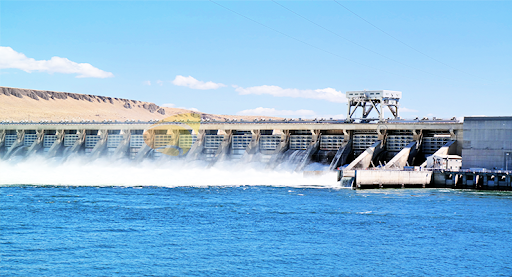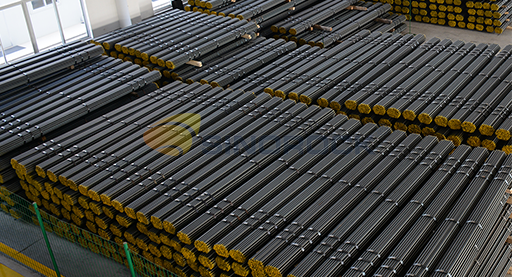Self-drilling hollow anchor rods in the treatment of disastrous slope
Time:2021-09-18From:sinorock View:
With the rapid development of social economy and infrastructure construction, the treatment of geological disasters such as high and steep slope collapses and landslides are facing new challenges. There are various forms of slope protection technology. In recent years, self-drilling hollow anchor rods have been widely used in various protection and reinforcement projects.
The following case shows the superiority of self-drilling hollow anchor rods in the treatment of hazardous geological slopes through the Yangjiang Nuclear Power Plant project. The Yangjiang Nuclear Power Station is located in Yangjiang City, Guangdong Province. The slope on the west side of the main plant area is a rock slope. Due to the impact of rain erosion and blasting construction, local slopes have collapsed and fallen blocks. To strengthen the local stability of the slope and determine the local protection and reinforcement treatment plan, plain concrete repair and self-drilling hollow anchor rod anchoring lattice structure are adopted. The anchor rod length is 6 m to 12 m, and the standard length is 6 m The anchor rod connection is lengthened. The self-drilling hollow anchor rod can meet the tensile and compression design anchoring force of 50kN-1500kN.
The mechanics’ principle of self-drilling hollow anchor rod can be summarized as follows:
(1) Anchor rod suspension function: The anchor rod penetrates the weak and loose rock and soil, and anchors into the stable ground to generate tensile force to prevent the slope cave wall from slipping and falling.
(2) Compression and reinforcement: the compression zones of adjacent bolts overlap each other to form a compression zone, which enhances the integrity and improves the bearing capacity.
(3) Combination beam (arch) function: After the anchor rod is inserted into the stratum to a certain depth, the stratum squeezes each other under the action of the anchoring force to enhance the bearing capacity of the stratum.
The practice of the slope protection and reinforcement treatment project on the west side of the main plant area of Yangjiang Nuclear Power Station proves that the self-drilling hollow bolt integrates drilling, grouting and anchoring. After the anchor rod is drilled, it can be used as a drill rod without pulling out. The hollow of the anchor rod is a grouting channel, and grouting is carried out from the inside to the outside. The three-in-one function of anchor rods can form anchor holes and ensure the effect of anchoring and grouting without special measures such as wall protection or pre-grouting during construction under various surrounding rock conditions. The self-drilling hollow anchor rod has a full-body thread, which can be cut and connected to lengthen arbitrarily, which can be applied to a relatively narrow construction space, and realizes the design idea of an extra-long anchor rod to strengthen surrounding rock. The high-efficiency stop plug keeps the grouting at pressure, fills the voids, and consolidates the broken rock mass. High-strength backing plates and nuts uniformly transfer the stress of the deep surrounding rock to the surrounding rock of the cave wall to achieve the purpose of supporting the surrounding rock. The self-drilling hollow bolt has a simple process, convenient and quick construction, and the construction efficiency of the traditional grouting bolt is increased by more than 30%.

Self-drilling hollow anchor rods bring great convenience to the treatment of disastrous geological slopes and the protection and reinforcement of slopes are more advanced, applicable and economical, and have an effect that other anchoring materials cannot replace.
Sinorock is a high-tech enterprise specializing in the research and development, production and sales of geotechnical anchorage engineering materials. Sinorock self-drilling hollow bolts are widely used in slope support, tunnel advance support, foundation pit support, foundation construction support, etc. For more than ten years, Sinorock products and services have won unanimous praise from customers in more than 40 countries and regions all over the world.
latest news
-

- What Are the Applications of SDA Bolts in Hydropower Stations?
- Time:2025-08-21From:This Site
- Learn how self-drilling anchor bolts enhance slope stability, tunnel support, and dam reinforcement in complex geological conditions at hydropower stations. Optimize hydropower projects with efficient, cost-effective, and eco-friendly solutions.
- View details
-

- Slope Stabilization with SDA Bolts: Benefits & Applications
- Time:2025-08-19From:This Site
- Discover how self-drilling anchor bolts (SDA bolts) provide superior slope stabilization for highways, railways, and tunnels. Learn their key benefits, installation process, and real-world applications in loose or collapsible soils.
- View details
-

- How Self-Drilling Rock Bolts Enhance Tunnel Support in Fractured Rock?
- Time:2025-08-15From:This Site
- Discover how self-drilling rock bolts enhance tunnel support in fractured rock. Learn their benefits, installation steps, and real-world applications for safe, efficient tunneling.
- View details
-

- Sinorock 2025 Quality Month | Strengthening Quality Foundations, Empowering Product Excellence
- Time:2025-08-13From:This Site
- Sinorock’s 2025 Quality Month, themed “Strengthening Quality Foundations, Empowering Product Excellence,” successfully concluded, reinforcing our commitment to superior product quality.
- View details
-

- Sinorock Safety Month 2025 | Everyone Speaks Safety, Everyone Can Respond
- Time:2025-07-03From:This Site
- Sinorock Safety Month 2025, centered on the theme "Everyone Speaks Safety, Everyone Can Respond - Spot Workplace Hazards," has wrapped up successfully!
- View details
-

- Quality Control: the Vital Factor of A SDA Bolt Factory
- Time:2025-01-09From:This Site
- Sinorock’s comprehensive quality control system, from supplier management to outgoing inspections, ensuring the highest standards for self-drilling anchor bolts in construction.
- View details
-

- Sinorock Invites You to Explore Proven Self-Drilling Anchor Bolt Solutions at bauma 2025
- Time:2025-03-07From:This Site
- From April 7–13, 2025, explore Sinorock’s Self-drilling anchor bolt solution at Booth C2.513/4 in Hall C2 of the Messe München Exhibition Center (Munich, Germany).
- View details
-
.jpg)
- SINOROCK to Attend EXPOMINA PERÚ 2024 in Lima, Peru
- Time:2024-08-10From:This Site
- Sinorock to Attend EXPOMINA PERÚ 2024 in Lima, Peru
- View details
-
.jpg)
- SINOROCK to Participate in MINING AND METALS CENTRAL ASIA 2024
- Time:2024-08-08From:This Site
- SINOROCK to Participate in MINING AND METALS CENTRAL ASIA 2024
- View details
 Download
Download 


